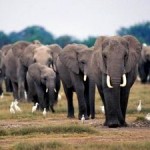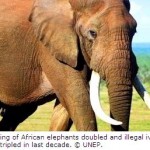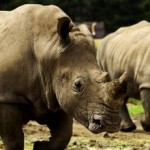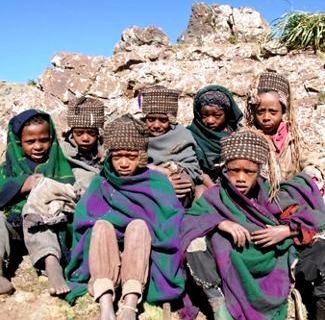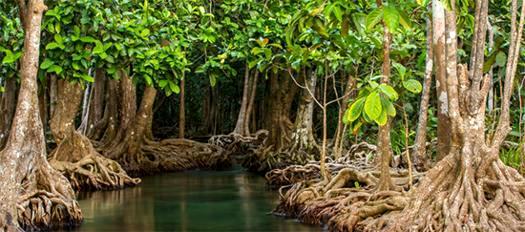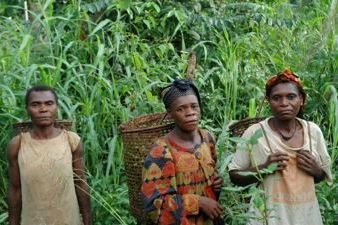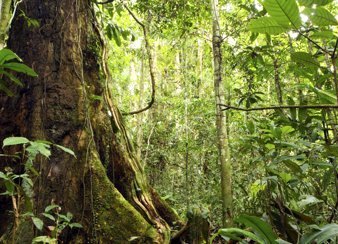
Gaborone, Botswana – As delegates gather to discuss the plight of the African Elephant at a summit convened by the Government of Botswana and the International Union for Conservation of Nature (IUCN), new analyses released yesterday find that if poaching rates are sustained at current levels, Africa is likely to lose a fifth of its elephants in the next ten years.
The latest analysis of poaching data estimates that in 2012 some 15,000 elephants were illegally killed at 42 sites across 27 African countries participating in Monitoring the Illegal Killing of Elephants (MIKE), a programme of CITES (the Convention on International Trade in Endangered Species of Wild Fauna and Flora), with funding from the European Union.
According to MIKE analysis, this amounts to an estimated 22,000 elephants illegally killed continent-wide in 2012, a slight reduction on the estimated 25,000 elephants poached in 2011.
“With an estimated 22,000 African Elephants illegally killed in 2012, we continue to face a critical situation. Current elephant poaching in Africa remains far too high, and could soon lead to local extinctions if the present killing rates continue. The situation is particularly acute in Central Africa – where the estimated poaching rate is twice the continental average,” said John E. Scanlon, CITES Secretary-General.
The IUCN/SSC African Elephant Specialist Group estimates the African Elephant (Loxodonta africana) population is around 500,000. Elephants in Central Africa are bearing the brunt of the poaching, although high-poaching levels in all sub-regions mean that even the large elephant populations in Southern and Eastern Africa are at risk unless the trend is reversed. Poverty and weak governance in elephant range States, together with rising demand for illegal ivory in consuming nations, are believed to be the key factors behind the increase in elephant poaching in recent years.
The high poaching levels are mirrored by the ivory trafficking figures compiled through the Elephant Trade Information System (ETIS) database, which TRAFFIC manages on behalf of the CITES Conference of the Parties. According to bias adjusted ETIS data, illicit trade in ivory rose in 2011 to the highest levels in at least 16 years and persists at unacceptably elevated levels through 2012.
Preliminary indicators suggest that even higher levels of illicit trade may be reached in 2013. Although incomplete, the raw data for large-scale ivory seizures in 2013 (involving at least 500 kg of ivory in a single transaction) already represent the greatest quantity of ivory confiscated over the last 25 years for this type of seizure. Large-scale ivory seizures typically indicate the participation of organized crime and so far 18 such seizures have yielded over 41.6 tonnes of ivory this year, but whether this reflects better law enforcement or a further escalation in trade will only be known when a full analysis of the 2013 data is possible sometime next year.
“From 2000 through 2013, the number of large-scale ivory movements has steadily grown in terms of the number of such shipments and the quantity of ivory illegally traded. 2013 already represents a 20% increase over the previous peak year in 2011; we’re hugely concerned,” said Tom Milliken, TRAFFIC’s Ivory Trade expert, who manages the ETIS database.
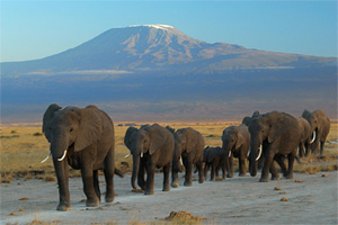 Since 2009, trade routes shifted from West and Central Africa seaports to East Africa, with Tanzania and Kenya as the primary exit points for illicit ivory leaving the continent. Malaysia, Viet Nam and Hong Kong are key transit points en route, with the ivory mostly destined for China, although Thailand is also a destination. But over the last two years, trade routes used by traffickers appear to be shifting as new countries such as Togo and Côte d’Ivoire emerge as exit points in Africa, with Indonesia, Spain, Sri Lanka, Turkey and United Arab Emirates as new transit countries.
Since 2009, trade routes shifted from West and Central Africa seaports to East Africa, with Tanzania and Kenya as the primary exit points for illicit ivory leaving the continent. Malaysia, Viet Nam and Hong Kong are key transit points en route, with the ivory mostly destined for China, although Thailand is also a destination. But over the last two years, trade routes used by traffickers appear to be shifting as new countries such as Togo and Côte d’Ivoire emerge as exit points in Africa, with Indonesia, Spain, Sri Lanka, Turkey and United Arab Emirates as new transit countries.
The latest poaching and trafficking figures were released as representatives of African Elephant range countries, as well as key transit and destination countries in the illegal ivory trade chain meet in Botswana. The meeting is expected to bring a strong commitment from the delegates to take concrete actions to halt the illegal trade and secure viable elephant populations across Africa, including strengthening national laws to tackle wildlife crime and enhancing cooperation within and between countries.
IUCN, through its Species Survival Commission (SSC) African Elephant Specialist Group, provides scientific data that underpins the Monitoring the Illegal Killing of Elephants programme and the Elephant Trade Information System.
“These monitoring systems continue to provide vital reliable data for decision-makers, and we are very pleased to be able to present updated information to the African Elephant Summit,” said Dr. Holly Dublin, Chair of the IUCN/SSC African Elephant Specialist Group. “The picture painted by this new information should provide motivation for all delegates at the Summit to come together to agree on much-needed urgent action on behalf of Africa’s elephants.”
“In the face of the overall bleak picture, we must remain diligent, but we are seeing for the first time in years some encouraging signs the poaching situation may be stabilizing. This gives us hope that if we continue to seriously step up enforcement and public awareness efforts across the entire illegal trade chain, support sustainable livelihoods for rural communities affected and remain ever vigilant, we can put the disturbing trends of recent years into reverse,” said Scanlon.
The African Elephant (Loxodonta africana) is currently listed in CITES Appendices I and II and as Vulnerable on The IUCN Red List of Threatened Species™.
Click here to read/download the Full Analysis – “Status of African Elephant Populations and Levels of Illegal Killing and the Illegal Trade in Ivory: A Report to the African Elephant Summit”.
Source: CITES, IUCN, TRAFFIC.

